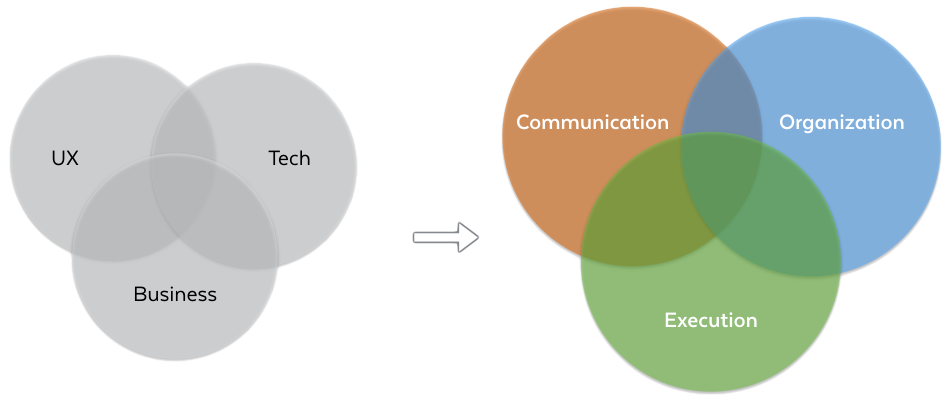25 Great Product Management Articles From 2016
2016 was the first full year I spent working as a Product Manager at Yammer. I try to take in and read as much as I can about product management (I share an article I read every day on my Twitter, @MrJefago). Product management is still a new and evolving field, so I find it super interesting to read how it varies between companies, how new revelations to some people are already obsolete to others, and how there is just so much to read and learn every day.
In this article, I wanted to share 25 of the best articles that I read this year. This list does not try to cover every great article out there, but rather give the top 5 articles in a number of categories: organization & processes, PM skills, teams & management, design & UX, and specific PM challenges.
5 Articles About Organization and Processes
How different companies set up their product teams and development processes varies quite a bit. Here are some articles shedding light on different aspects of product development organization and processes.
Functional versus Unit Organizations
 Functional versus Unit Organizations
Functional versus Unit Organizations
Some personal history, and pros/cons of organization structure.Steven Sinofskymedium.learningbyshipping.com
At the highest level, in this article the always great Steven Sinofsky talks about functional (e.g., PM, engineering, design, marketing) vs. unit (e.g., product or product area) organizations. Of course, both have their advantages and disadvantages, and Steven talks through them all, along with some tips for how to implement them successfully.
How Amazon Web Services (AWS) Achieved an $11.5B Run Rate by Working Backwards
 How Amazon Web Services (AWS) Achieved an $11.5B Run Rate by Working Backwards
How Amazon Web Services (AWS) Achieved an $11.5B Run Rate by Working Backwards
In 2006, after Amazon Web Services (AWS) helped pioneer what we now call the cloud, product development changed forever. What once took…hitenism.com
This article by Hiten Shah looks specifically at Amazon’s development process along with some more general product management best practices. The key trick of the Amazon process that Hiten talks about is envisioning what the future will look like after the product (or feature) has been successfully implemented.
Shipping vs. Learning
 Shipping vs. Learning
Shipping vs. Learning
“What did you ship last quarter?”Mike Davidsonmedium.mikeindustries.com
A great post by Mike Davidson, who (in my mind, absolutely correctly) argues that you shouldn’t maximize for shipping the highest number of features, but rather maximizing the learning. You can learn, of course, in other ways than shipping features — for example, by prototyping, user testing, etc. The Lean Startup cycle is Build — Measure — Learn, but if you can learn without building something first, all the better!
The MVP is dead. Long live the RAT.
 The MVP is dead. Long live the RAT.
The MVP is dead. Long live the RAT.
Why you should focus on Riskiest Assumption Tests and forget about MVPs.Rik Highammedium.com
Continuing along the path of “maximizing learning”, this article by Rik Higham (which is worth a read despite the clickbaity title) argues that what you build in the first iteration should not focus on minimum viability, but rather on testing the riskiest assumption — in order to minimize the time to the maximum learning. I would argue that an MVP can be defined in a way to do exactly that (and it sounds like Rik doesn’t exactly disagree), but it’s worth keeping his thoughts in mind when you scope the next MVP.
12 Signs You’re Working in a Feature Factory
 12 Signs You’re Working in a Feature Factory
12 Signs You’re Working in a Feature Factory
I’ve used the term Feature Factory at a couple conference talks over the past two years.John Cutlerhackernoon.com
John Cutler is probably the most prolific product management writer these days, so how could I write a list like this without one of his articles. This one talks about fallacies to avoid in organizing your development process. I believe we do most of these right at Yammer, but his points do offer an opportunity to reflect and find improvement opportunities.
5 Articles That Feature Venn Diagrams
Alright, they don’t all have Venn diagrams. They all talk about product management skills, though, and that seems to be almost impossible to do without the overlapping circles “Technology — UX — Business”.
MVPM: Minimum Viable Product Manager
 MVPM: Minimum Viable Product Manager
MVPM: Minimum Viable Product Manager
You’ve probably seen this diagram before. It elegantly shows that product management is the intersection of a diverse skill set.Brandon Chumedium.com
In this article, Brandon Chu aims to define what the minimum skills / knowledge in each of the circles of the Venn diagram a PM should at least have in order to be effective. This is of course a hard job, since the PM role can vary quite a bit from company to company, but it’s a great start, especially for someone new to the PM role.
Learning in Product
 Learning in Product
Learning in Product
Too much Product content still relates to “what is “Product” (ugh), “how to get into Product” (ok cool, but then what), and “do we really…Ellen Chisablog.ellenchisa.com
Ellen Chisa is one of my favorite writers about product management. Starting from the omnipresent Venn diagram, but not confining herself to it, she talks about how a PM can think about learning and development, in order to fill the gaps in their capabilities.
A New Skill Model for Product Managers
 A New Skill Model for Product Managers
A New Skill Model for Product Managers
From “UX / Tech / Business” to “Communication / Organization / Execution”Matt LeMaymedium.com
With this article, we are reaching peak Venn. In this article, Matt LeMay argues that we need another Venn diagram to define product management skills, namely communication — organization — execution. Kidding aside, I do think that thinking about product management not just as the overlap of the domains of technology, UX, and business, but also as a combination of the skills Matt describes, is a valuable addition to the dialog about PM.
The Bipolar Nature of Product Management
The Bipolar Nature of Product Management
The best product managers are bipolar in many ways.John Varsmedium.com
This article doesn’t have any Venn diagrams. In fact, it doesn’t have any diagrams. Shocker! Instead, John Vars talks about the dichotomies that PMs must navigate, for instance between high-level strategic thinking, and getting down into the weeds to ensure all the kinks are ironed out. Worth a read!
A Product Manager Communication Survival Guide
 A Product Manager Communication Survival Guide ft. @johncutlefish
A Product Manager Communication Survival Guide ft. @johncutlefish
Or, how to tame information overloadNichole Elizabeth DeMerémedium.com
This article by Nichole Elizabeth DeMeré focuses on communication — after all, that is one of the primary roles of a PM in that Venn diagram intersection. Some good thoughts in here about the role of the PM and how to avoid drowning in the ocean of information.
5 Articles About Design and UX
To build great products today, you have to understand design and user experience, period. Design can be one of the few remaining sources of competitive advantage in a world of zero marginal costs. So here are some articles about that topic.
5 Things I Learnt as a Designer at LEGO
 5 Things I Learnt as a Designer at LEGO
5 Things I Learnt as a Designer at LEGO
At 5am on a cold, misty morning, my plane tumbled to a stop in a strange land where I didn’t speak a word of the language. I was about to…Johnny makes ⚡5thingsilearned.com
Who doesn’t love Lego? I certainly do! And Jonathan Bree was a designer there! Even beyond the inner child, though, this article has some takeaways that apply to virtual interfaces and non-toy products as well. A great read!
Why design principles shape stronger products
 Why design principles shape stronger products
Why design principles shape stronger products
Our design team didn’t have any design principles and it was difficult to determine design success.Jessie Chenuxdesign.cc
I really enjoyed this article by Jessie Chen since it was so hands-on, and instead of being academic and theoretical, it talked through the actual challenges faced by the team as they developed design principles for a legacy product, and the advantages of having those principles in place.
Design decisions: Junk drawers and dark corners
 Design decisions: Junk drawers and dark corners
Design decisions: Junk drawers and dark corners
Unless what you’re building is so small, so tight, so single purpose, it seems like every product accumulates some extras that just need…Jason Friedmedium.com
Jason Fried shines a light into dark corners and junk drawers in this piece, to highlight the dangers of keeping small, obscure features in the product that kind of don’t fit anywhere.
What Can You Remove from Your Product?
What Can You Remove from Your Product? • Tomasz Tunguz
Perfection is finally attained not when there is no longer anything to add, but when there is no longer anything to take away. Antoine de…tomtunguz.com
In a way as a continuation of the previous article, Tom Tunguz argues for removing features from your product to reduce complexity. He describes the product debt that each and every feature incurs in the product. I completely agree with his description of the issue: Each feature you keep around does not just add to the complexity, it multiplies it, until your product development gets paralyzed.
Why The Heck Can’t We Change Our Product?
 Why The Heck Can’t We Change Our Product?
Why The Heck Can’t We Change Our Product?
I drove by the fork in the road and went straight.Steven Sinofskymedium.learningbyshipping.com
The second article by Steven Sinofsky in this list, and too long to summarize in one paragraph. He talks about all the reasons why change becomes harder and harder as a product matures, and how to address them. Since I can’t summarize it, you’ll have to go read it!
5 Articles About Teams and Management
Product managers are team players. Product management is defined as “the glue between” other teams, so fundamentally, a PM has to always be the orchestrator and facilitator that makes sure everyone works together smoothly. Of course, most PMs do not actually have the team reporting to them, but many management practices still apply in order to make the team effective.
What Highly Effective Product Teams Are Doing Differently — ProdPad
 What Highly Effective Product Teams Are Doing Differently - ProdPad
What Highly Effective Product Teams Are Doing Differently - ProdPad
Five things that product-focused teams pretty much insist on.www.prodpad.com
This article by Janna Bastow has a whole lot of best practices for building effective product teams. Some fall more in the process and organization category, others more in the team building category. In any case, it’s worth a read!
10 Ways PMs Can Earn The Respect and Trust of Their Team
 10 Ways PMs Can Earn The Respect and Trust of Their Team
10 Ways PMs Can Earn The Respect and Trust of Their Team
… because once you’ve lost it, you’re pretty screwedJohn Cutlerhackernoon.com
Another John Cutler listicle: 10 great hands-on tips for PMs to create and maintain the respect of the team.
Team Health Monitors and Why Your Startup Needs a Check-up
 Team Health Monitors and Why Your Startup Needs a Check-up
Team Health Monitors and Why Your Startup Needs a Check-up
Atlassian president Jay Simons makes the case for team health monitors and explains how to evaluate for the eight traits of high-performing…firstround.com
I really loved this article how Atlassian defines and monitors team health. The article talks at length about structures and processes for regularly monitoring team health, but even if you don’t go that far, the dimensions that the article outlines for team health and how to create a well-functioning team are worth reviewing for your own project teams.
The Power of the Elastic Product Team — Airbnb’s First PM on How to Build Your Own
 The Power of the Elastic Product Team — Airbnb’s First PM on How to Build Your Own
The Power of the Elastic Product Team — Airbnb’s First PM on How to Build Your Own
Over the last 5 years, Jonathan Golden has watched Airbnb explode in size and productivity. Here's what that journey looked like on the…firstround.com
This fascinating article about AirBnB’s product org takes the team aspect to a higher level: How to build up and scale an entire product organization. The article is maybe most relevant for startup founders or VPs of Product, but there is just so much goodness in it that I’m sure you’ll find something of value too.
Diverse Teams Feel Less Comfortable — and That’s Why They Perform Better
 Diverse Teams Feel Less Comfortable — and That’s Why They Perform Better
Diverse Teams Feel Less Comfortable — and That’s Why They Perform Better
Homogenous groups aren’t as effective as they seem.hbr.org
I strongly believe in the value of diversity, and that the inability of Silicon Valley tech companies to make more headway is somewhat self-inflicted. This great HBR article is another great proof point for how diverse teams perform better — even though they might feel less “comfortable” in the process.
5 Articles About Specific Product Management Challenges
My last section features some articles that talk about specific aspects of product management that didn’t fit in any of the other sections. So, without further introduction, here we go:
Ants and Aliens
 Ken Norton: Ants and Aliens
Ken Norton: Ants and Aliens
”There is no point in having a 5-year plan in this industry. With each step forward, the landscape you’re walking on changes. So we have a…www.kennorton.com
There can of course be no list of PM articles without a contribution by the fantastic Ken Norton. In this article about product strategy, Ken argues for having a thirty-year plan. Thirty years?! Yes — in order to forget all the short-sighted constraints and challenges and focus on building a vision for the future.
Understanding your users’ mental model
 Understanding your users' mental model | Inside Intercom
Understanding your users' mental model | Inside Intercom
How sketch research can help you get inside the minds of your users and build more intuitive products.blog.intercom.com
This article is about user research — specifically, about using sketching and drawing to find out how users think about certain concepts. I find the idea incredibly powerful, and while I haven’t yet applied it in practice, I certainly look forward to trying it in future!
The Five Types of Virality
 The Five Types of Virality
The Five Types of Virality
and choosing the right one for your product to growJosh Elmannews.greylock.com
In any product with a network effect, growth is incredibly important, and often, virality is one of the key ways of getting that growth. This article by Josh Elman from Greylock is basically the definitive way of how to think about virality and how to achieve it.
Ways to think about customer onboarding — Inside Intercom
 Ways to think about customer onboarding | Inside Intercom
Ways to think about customer onboarding | Inside Intercom
The stakes have changed when it comes to onboarding users. It's about using context, time, and behavior as much as you can to help…blog.intercom.com
Great onboarding is essential for most products without a captive audience. If you can’t convince the new user that there’s value for them when they first use the product, chances are they won’t come back. This Intercom blog post by Colin Bentley talks about the different “generations” of user onboarding and how it has evolved.
Product Management for the Enterprise
 Product Management for the Enterprise
Product Management for the Enterprise
(Interested in more on this topic? Check out my book with co-author Ben Gaines from Adobe Analytics: Building Products for the Enterprise…Blair Reevesmedium.com
Enterprise software products are different — so while many of the jobs of a PM are similar for enterprise products, they might require slightly different skills and approaches. In this article, Blair Reeves does a great job of summarizing the key differences
I hope you found these articles as useful as I did! If it was, feel free to follow me on Twitter where I share interesting product management articles I come across daily.
